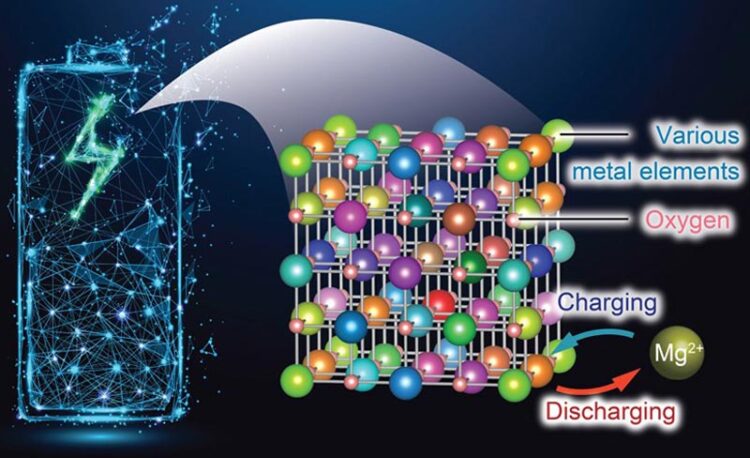Unleashing disordered rocksalt oxides

The present material contains many metal elements as cations thanks to the effect of the high configurational entropy.
Credit: Tohoku University
… as cathodes for rechargeable magnesium batteries.
Researchers at Tohoku University have made a groundbreaking advancement in battery technology, developing a novel cathode material for rechargeable magnesium batteries (RMBs) that enables efficient charging and discharging even at low temperatures. This innovative material, leveraging an enhanced rock-salt structure, promises to usher in a new era of energy storage solutions that are more affordable, safer, and higher in capacity.
Details of the findings were published in the Journal of Materials Chemistry A on March 15, 2024.
The study showcases a considerable improvement in magnesium (Mg) diffusion within a rock-salt structure, a critical advancement since the denseness of atoms in this configuration had previously impeded Mg migration. By introducing a strategic mixture of seven different metallic elements, the research team created a crystal structure abundant in stable cation vacancies, facilitating easier Mg insertion and extraction.
This represents the first utilization of rocksalt oxide as a cathode material for RMBs. The high-entropy strategy employed by the researchers allowed the cation defects to activate the rocksalt oxide cathode.
The development also addresses a key limitation of RMBs – the difficulty of Mg transport within solid materials. Until now, high temperatures were necessary to enhance Mg mobility in conventional cathode materials, such as those with a spinel structure. However, the material unveiled by Tohoku University researchers operates efficiently at just 90°C, demonstrating a significant reduction in the required operating temperature.
Tomoya Kawaguchi, a professor at Tohoku University’s Institute for Materials Research (IMR), notes the broader implications of the study. “Lithium is scarce and unevenly distributed, whereas magnesium is abundantly available, offering a more sustainable and cost-effective alternative for lithium-ion batteries. Magnesium batteries, featuring the newly developed cathode material, are poised to play a pivotal role in various applications, including grid storage, electric vehicles, and portable electronic devices, contributing to the global shift towards renewable energy and reduced carbon footprints.”
Kawaguchi collaborated with Tetsu Ichitsubo, also a professor at IMR, who states, “By harnessing the intrinsic benefits of magnesium and overcoming previous material limitations, this research paves the way for the next generation of batteries, promising significant impacts on technology, the environment, and society.”
Ultimately, the breakthrough is a major step forward in the quest for efficient, eco-friendly energy storage solutions.
Journal: Journal of Materials Chemistry A
DOI: 10.1039/D3TA07942B
Article Title: Securing cation vacancies to enable reversible Mg insertion/extraction in rocksalt oxides
Article Publication Date: 15-Mar-2024
Media Contact
Public Relations
Tohoku University
public_relations@grp.tohoku.ac.jp
All latest news from the category: Materials Sciences
Materials management deals with the research, development, manufacturing and processing of raw and industrial materials. Key aspects here are biological and medical issues, which play an increasingly important role in this field.
innovations-report offers in-depth articles related to the development and application of materials and the structure and properties of new materials.
Newest articles

Sea slugs inspire highly stretchable biomedical sensor
USC Viterbi School of Engineering researcher Hangbo Zhao presents findings on highly stretchable and customizable microneedles for application in fields including neuroscience, tissue engineering, and wearable bioelectronics. The revolution in…

Twisting and binding matter waves with photons in a cavity
Precisely measuring the energy states of individual atoms has been a historical challenge for physicists due to atomic recoil. When an atom interacts with a photon, the atom “recoils” in…

Nanotubes, nanoparticles, and antibodies detect tiny amounts of fentanyl
New sensor is six orders of magnitude more sensitive than the next best thing. A research team at Pitt led by Alexander Star, a chemistry professor in the Kenneth P. Dietrich…





















